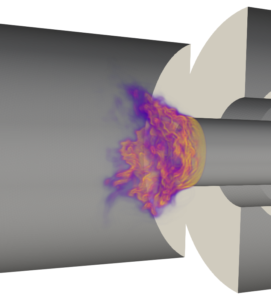Prediction of pollutants and design of low-emission burners
Short description
The harmful effects for human health of pollutants like NOx and CO have boosted their experimental and numerical study during the last years. However, their relatively long timescales have required to increase the level of complexity of turbulent combustion models in order to obtain accurate predictions as emphasized in Valera-Medina et al. 2019 and Karagöz et al. 2019. Moreover, the use of alternative hydrogen-based fuels, even reducing CO and other HC emissions (Cappelletti and Martelli, 2017) and increasing engine efficiency (Verhelst et al.,2009), may have dramatic effects on NOx emissions compared to conventional fuels. For these fuels three times higher amounts of NOx have been measured compared to gas natural in some operational conditions for gas turbines (Riccio et al. 2009) although some studies show that the combined use of ammonia and hydrogen have potential to reduce NOx production (Xiao and Valera-Medina, 2017). Finally, technologies with hydrogen burners need development as the mixing strategies have to be adjusted since H2 is much lighter than natural gas(Cappelletti and Martelli, 2017). Therefore, there is need to extend the knowledge about pollutant emissions not only for conventional fuels used in current engines but for hydrogen blends in order to produce innovative concepts.
Objectives
To optimize burner performance in terms of pollutant emissions making use of large-scale simulations. Advanced combustion and soot models will be used to pursue this objective. This use case will make tangible the potential of HPC as an important tool to increase reliability and accuracy in numerical simulations for practical applications with a strong industrial focus.

Technologies
CLIO, Alya, Nek5000, OpenFOAM, PRECISE_UNS
Use Case Owner
Barcelona Supercomputing Center (BSC)
Collaborating Institutions
BSC, RWTH, TUE, UCAM, TUD, ETHZ, AUTH

